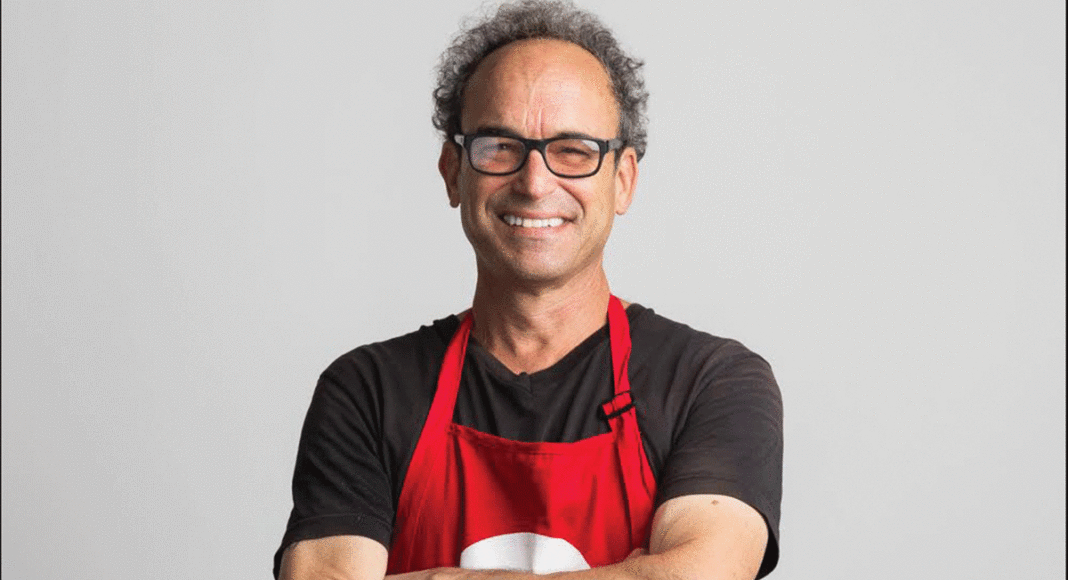The first time I walked into the sculpture garden at the Felix Kulpa seven years ago, I was in awe. The Steve Jobs memorial and phone booth fountain, the iconic, fully functioning found-item guitars—like the one made out of a toilet seat and the one made out of a Millennium Falcon model—I’d never seen anything like it. “This is Santa Cruz,” I remember thinking. Even more so, though, this is Robbie Schoen. As the director of the Kulpa since 2002, and an exhibition coordinator at the Museum of Art and History (MAH), Schoen has become a catalyzing force in the local art scene.
Which is why I was pretty nervous last week when I rushed out of our downtown office to visit him in Capitola, where he is recovering from a massive stroke. When I arrived at Pacific Coast Manor, he was sitting in his wheelchair, a sizable chunk of his skull noticeably absent from the right side of his head. But his sense of humor remained intact—he was joking with the nurse administering his electrical stimulation, singing a little tune: “Christina, the village queen-a,” and chuckling.
“It’s just that smile that Robbie greets you with, it’s filled with light,” says Rose Sellery, one of the organizers of Art for Robbie, an art sale fundraiser at the MAH on June 17 to benefit Shoen’s recovery.
On February 10, a blood clot shot through Schoen’s carotid artery, into his brain, and started to hemorrhage. He was airlifted to Stanford where they removed a portion of his skull to allow the brain’s swelling to subside (the surgery to replace it was on June 6).
When he first came to in the hospital, Schoen was confused, he remembers.
“I was coming to grips with the reality of my condition: ‘Oh, my left hand doesn’t work right now, oh. I won’t be hanging art for a while.’ And then time is going by and going by and piling up, and you’re laying in bed more than you ever have in your entire life, with a diaper on,” says Schoen. “And then I have obsessions, and I’m impulsive, so I’m trying to do stuff from the bed, like my taxes. I exhaust the people who are helping me, because I’m like a rocket.”
The right side of Shoen’s brain was the most impacted by his stroke, so it’s his left extremities that were rendered immobile. He can’t use his left side, and can’t read the first two words of a sentence. At the MAH, where Schoen started in 2006, he was constantly climbing 12-foot ladders, hanging projectors, mounting art and informational panels.
Still, he finds things to keep his spirits up.
“I watched all three Hannibal Lecter movies the other day, and now I just look at people and think, ‘How can I eat their face?’” Schoen says with a smirk and a laugh.
That’s Robbie, says Marla Nova, who’s worked alongside Schoen at the MAH for more than a decade.
“He gets away with it because he smiles and goes ‘ahahah.’ He always makes things fun,” says Novo. “It’s a really great thing to work with people that you enjoy.”
On Feb. 10, Novo had a haircut appointment behind the MAH at noon. On her way, she saw Schoen setting up for the museum’s annual Red Ball.
“Every time I’ve ever seen Robbie throughout the years we acknowledge each other, and I was late for my appointment so I saw him and he didn’t say anything. Then I went to my hair appointment and about 10 minutes later he had the stroke. It always haunted me that I didn’t get to say hi to him.”
Thankfully, says Novo, Schoen happened to be in the second-floor Solari gallery at the MAH where visitors saw him collapse and called 911.
“That was a hard day. It still seems unreal when someone’s life is changed so drastically,” she says. “But then you look for the happy moments and see that he has such loving support around him. He wants to get better and is getting better, that’s a beautiful thing.”
So far, 130 local artists have rallied around Schoen by donating their works for the Art for Robbie event—which is the day after Schoen’s 59th birthday, and will serve as an extra big birthday celebration for the guest of honor.
They’ve had to start turning artists away, says Sellery, because the MAH won’t be able to hold all the art donated for the event, which will offer all pieces for $200, in addition to a live auction featuring the works of Thomas Campbell, Glenn Carter, Tobin Keller, Tim Craighead, Coeleen Kiebert, Daniella Woolf, and Schoen.
There’ll be mixed media, sculptures, paintings, prints, a little bit of everything from the community’s best-known artists, says Sellery, program director for the Cabrillo Gallery.
“What we realized is he needs more care than what his subsidized insurance can give, and there is such a long road to recovery,” says Sellery.
That’s why all proceeds from the event benefit Schoen’s recovery, says Sellery, in addition to the youcaring.com page, set up for direct donations by his daughter, Nikita.
“More than 1,000 people have shared on Facebook about [the page]. People are donating and sending cards,” says Sellery. “When you see someone who’s that beloved in the community it’s really amazing and inspiring. I want to be like Robbie.”
Weeks ago, Schoen told his partner, Jet—who has MS, and for whom Schoen was previously the primary caretaker—that he dreamt his MAH coworkers had come to the hospital with protest signs to get him out.
So, that’s precisely what they did.
“He’s touched so many people and they’re here and rallying for him. He’s always so thankful to everybody helping,” says Novo. “The last time we talked I said ‘It’s going to be a great summer,’ and he said, ‘Yeah it is, I survived.”
Info: 4 p.m., Saturday, June 17. Museum of Art and History, 705 Front St., Santa Cruz. felixkulpa.com. Free.














